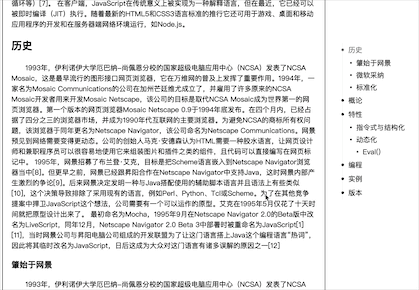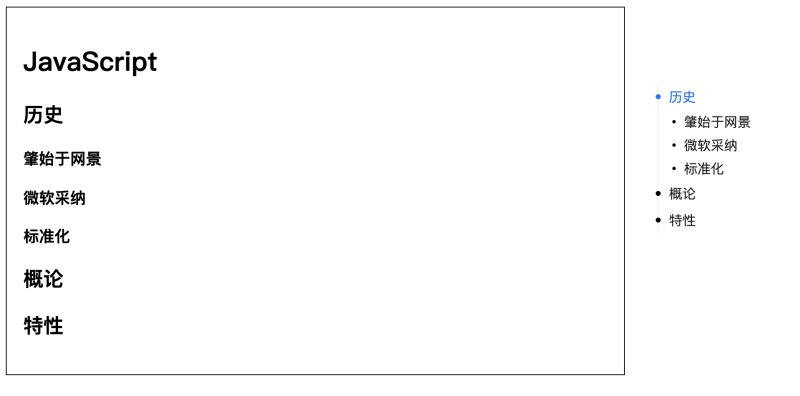最近要做一个侧边目录的功能,没有找到类似的组件,索性自己写了一个供大家参考
vue-side-catalog
一个基于vue的侧边目录组件。

源码地址:https://github.com/yaowei9363/vue-side-catalog
安装
npm install vue-side-catalog -S
开始
<template>
<div id="app">
<div class="demo">
<h2>JavaScript</h2>
<h3>历史</h3>
<h4>肇始于网景</h4>
<h4>微软采纳</h4>
<h4>标准化</h4>
<h3>概论</h3>
<h3>特性</h3>
</div>
<side-catalog
v-bind="catalogProps"
></side-catalog>
</div>
</template>
import SideCatalog from 'vue-side-catalog'
import 'vue-side-catalog/lib/vue-side-catalog.css'
export default {
components: {
SideCatalog,
},
data() {
return {
catalogProps:{
containerElementSelector: '.demo',
},
};
},
}
注意: containerElementSelector 属性是必需的,指定文章的容器。
效果如下图:

示例
自定义目录标签
组件默认会把containerElementSelector元素的直接子集的header标签作为目录内容,
对应规则为:
h3 => 一级目录
h4 => 二级目录
h5 => 三级目录
h6 => 四级目录
要修改这一规则可以使用 headList 属性,这个属性的默认值为["h3", "h4", "h5", "h6"]对应上述规则
注意:自定义题目标签目前只支持containerElementSelector元素的直接子集的html标签
data(){
return {
catalogProps:{
headList: ["h2", "h3", "h4", "h5", "h6"], // 使h2作为一级目录
// headList: ["h4", "h2", "p", "span"], // 指定不同的标签为目录
},
};
},

自定义目录元素
跟上面的自定义目录标签不同,自定义目录元素可以支持任意层级的含有ref属性的元素,也可以支持组件
需要用到 refList 属性
<template> <h2>JavaScript</h2> <h3 ref="t1">历史</h3> <h4 ref="t1-1">肇始于网景</h4> <h4 ref="t1-2">微软采纳</h4> <h4 ref="t1-3">标准化</h4> <h3 ref="t2">概论</h3> <h3 ref="t3">特性</h3> <version ref="t4"/> <!-- ... --> </template>
//...
import Version from './components/Version';
export default {
components: {
// ...
Version,
},
data() {
return {
catalogProps:{
containerElementSelector: '.demo',
refList:[
{
ref: 't1'
},
{
ref: 't1-1',
level: 2 // 指定为二级目录
},
{
ref: 't1-2',
level: 2
},
{
ref: 't1-3',
level: 2
},
{
ref: 't2'
},
{
ref: 't3'
},
{
ref: 't4',
title: '版本' // 组件需要单独设置title(默认取innerText)
},
]
},
};
},
}
效果如下图:

注意:headList和refList同时设置的话,会忽视headList
指定元素滚动
也可以使用 scrollElementSelector 对固定元素的内容生成目录,如果不指定该属性则默认监听Window的scroll事件
data(){
return {
catalogProps:{
scrollElementSelector: '.demo',
},
};
},
.demo {
height: 400px;
overflow: auto;
}
效果如下图:

在线示例
点击这里
Props
| Name | Type | Default | Description |
|---|---|---|---|
| headList | Array | ["h3", "h4", "h5", "h6"] | 为每级目录指定标签 |
| refList | Array | - | 为每级目录指定ref元素,数组每项为对象,包含两个属性<ul><li>ref(必需)该行目录对象的refName</li><li>title该行目录的名称(默认取innerText)</li><li>level(默认为1)该行目录级别</li></ul> |
| containerElementSelector | String | - | (必需)指定文章的容器 |
| scrollElementSelector | String | Window | 需要添加scroll事件的css选择器,默认监听window的scroll事件 |
| openDomWatch | Boolean | false | 是否开启dom监听,如果containerElementSelector中有dom变化会重新计算每级目录的offsetTop |
Methods
| Name | Parameters | Description |
|---|---|---|
| initActive | - | 使目录第一行处于active状态 |
| setRefList | - | 计算每级目录的offsetTop |
Slot
| Name | Description |
|---|---|
| - | 目录的题目 |
以上就是本文的全部内容,希望对大家的学习有所帮助,也希望大家多多支持亿速云。
免责声明:本站发布的内容(图片、视频和文字)以原创、转载和分享为主,文章观点不代表本网站立场,如果涉及侵权请联系站长邮箱:is@yisu.com进行举报,并提供相关证据,一经查实,将立刻删除涉嫌侵权内容。